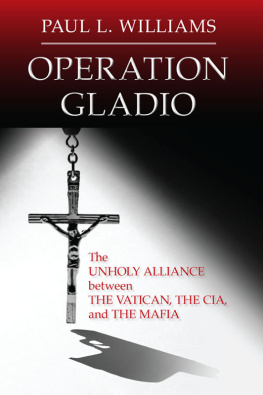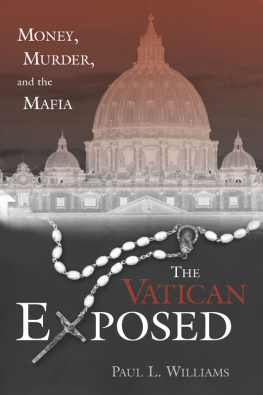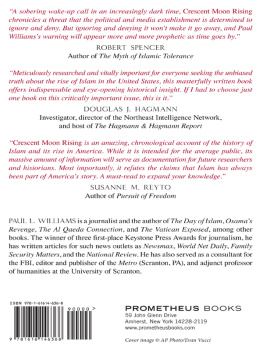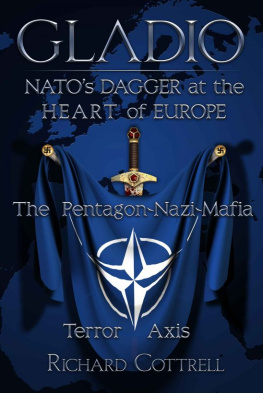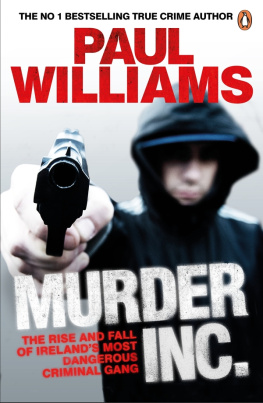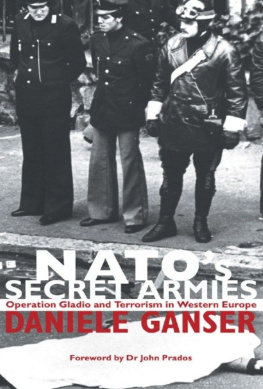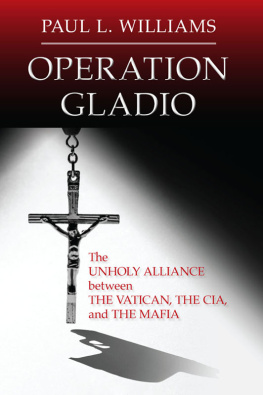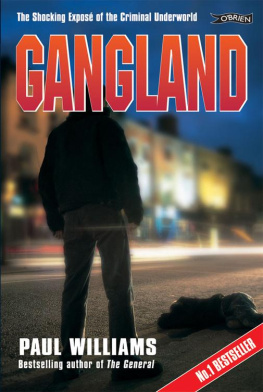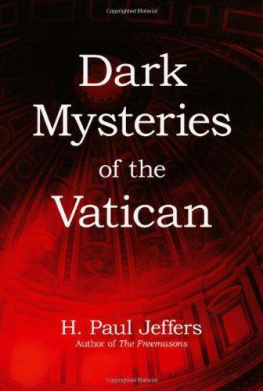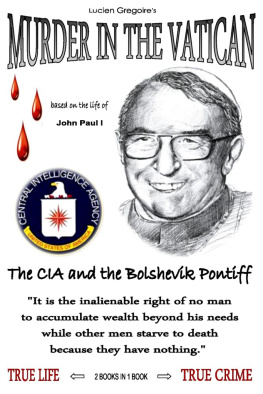
The 1,100+ footnotes in this book attest to my reliance on the work of others, particularly such scholars as Alfred McCoy, Peter Dale Scott, Martin A. Lee, Dale Yallop, and Sibel Edmonds, who have uncovered material by unprecedented spade work that should be of interest to all seekers of the truth. I would be remiss if I did not mention the following researchers and journalists who met with untimely deaths by probing into the matter of Gladio: Gary Webb, Giorgio Ambrosoli, Carmine Pecorelli, Emilio Alessandrini, Antonio Varisco, Boris Giuliano, Giuseppe Della Cha, General Alberto Dalla Chiesa, and Uur Mumcu. As always, I am indebted to Jonathan Kurtz, Steven Mitchell, and the staff at Prometheus, my very courageous publishing company. Finally, I must acknowledge my wife Patricia, who has been my staunchest supporter throughout our forty-three glorious years of marriage, and Judith Schmitt and Judith Forte, who continue to keep me in their prayers.

I know what you're thinking.
The author of this book must be a Baptist.
It's a common assumption.
Most Welsh people are Baptists and Williams is a Welsh name.
But names are deceptive.
I was born and raised a Roman Catholic. My parish was St. John the Baptist Church in West Scranton, where I learned by rote the Baltimore Catechism and sang Panis Angelicus with the choir. I wrote JMJ (Jesus, Mary, and Joseph) on the right hand corner of my composition papers, went to confession every Saturday afternoon, and received Holy Communion at Sunday Mass. I participated in all the rites and ritualsthe Forty Hour Devotion to the Blessed Sacrament, the recitation of the litanies to the saints, and the yearly novenas at St. Ann's Basilica.
In those Tridentine days, the liturgy was in Latin, which gave the Mass a sense of timelessness and the assurance that the teachings of Holy Mother Church were semper eademalways the samebinding the generations in one system of belief.
I had my throat blessed on the feast of St. Blaise and my forehead anointed with ashes on the first day of Lent. I wore a St. Christopher's medal and a scapular. I fasted and abstained on the days appointed and received all the sacraments, save Holy Orders and Extreme Unction.
As a graduate student at Drew University, my mentor was Fr. Gabriel Coless, an Augustinian monk, who provided rigorous instruction in the Patristics and Medieval Latin. After receiving my doctorate, I taught religion and the humanities at the University of Scranton, a Jesuit institution, and served as the editor of the annual proceedings of the Fellowship of Catholic Scholars. I also penned a number of articles on Vatican II and the effects of aggiornamento for National Review, where I met William Buckley, the celebrated CIA spook.
I encountered the wrath of Rome while writing Everything You Always Wanted to Know about the Catholic Church for Doubleday. Doubleday, at that time, was a publishing outlet for the Catholic Church through its imprint, Image Books, and an imprimatur was considered a prerequisite for publication. My clerical overseers found no fault with my handling of the evolution of doctrine and the matter of the pontiffs who later were decried as heretics. The problem arose with the subject of the Church's temporalities. I was told to expunge all references to the Vatican Bank, including the donation of Mussolini, the Ambrosiano affair, and the P2 scandal. These topics had garnered headlines throughout the world and to exclude them from a book with a tell-all title would be an act of obsequiousness that bordered on cowardice. I refused to make the suggested cuts and was supported in my decision by Patricia Kossman, my intrepid editor. In 1990, the work was published by Doubleday without a nihil obstatthe declaration that nothing about the work is contrary to the faithdespite the fact that it contained no canonical errata.
In subsequent years, I probed deeper into the affairs of Vatican, Inc., during my tenure as the editor and publisher of the Metro, and as a consultant (CI-9) for the FBI. My findings, including the ties between the Vatican and Gambino crime family, constituted the core of The Vatican Exposed: Money, Murder and the Mafia, which was published by Prometheus in 2001.
For the past fourteen years, I have been engaged in combing all available government records regarding the Vatican, the CIA, and the Mafia. The task has been grueling, since most of the fileseven the files of Pope Paul VI, Michele Sindona, Roberto Calvi, Archbishop Paul Marcinkus and other individuals long deadremain classified; any disclosure of their contents would represent a threat to national security. Fortunately, enough information has come to light in recent years that readers can obtain a complete account of the unholy alliance of Gladio.
Am I still a Catholic?
Suffice it to say, anyone who attempts to come to terms with the facts presented in these pages will have his faith in Holy Mother Church compromised, if not shattered.

The Association for Responsible Dissent estimates that by 1987, six million people had died as a result of CIA covert operations. Former State Department official William Blum correctly calls this an American Holocaust. The CIA justifies these actions as part of its war against communism. But most coups do not involve a communist threat. Unlucky nations are targeted for a wide variety of reasons: not only threats to American business interests abroad, but also liberal or even moderate social reforms, political instability, the unwillingness of a leader to carry out Washington's dictates, and declarations of neutrality in the Cold War. Indeed, nothing has infuriated CIA Directors quite like a nation's desire to stay out of the Cold War.
Steve Kangas, A Timeline of CIA Atrocities, 1994
We're fighting the wrong enemy.
Allen Dulles, the Swiss director of the US Office of Strategic Services (the OSS), came to this conclusion at the close of 1942, when the German infantry remained mired in the mud and snow of the Russian steppes. He had received word via Vatican messengers from Schutzstaffel (SS) chief Heinrich Himmler and Walter Schellenberg, head of the Sichterheitsdienst (the SS foreign intelligence service), that the Nazi government wished to establish a separate peace with the United States. Such reconciliation would enable the Third Reich to turn its undivided attention to pulverizing the Soviets. When Dulles expressed his openness to discuss the proposal, the German High Command sent Prince Max von Hohenlohe, a Prussian aristocrat and businessman, to meet with him in Bern.
SEEING RED
In a series of communiqus with William (Wild Bill) Donovan, the OSS chief in Washington, Dulles expressed his eagerness to pursue the peace negotiations, believing that the Soviets posed a far greater threat to the United States and to the stability of the Western world than the Nazis. The Soviets, Dulles maintained, committed acts of genocide that far surpassed the pogroms of the Third Reich. They endorsed a godless ideology that called for world revolution and the collapse of capitalism. They believed that human history was governed by the process of dialectical materialism, the idea that any current economic order would always give rise to its opposite, a process that would terminate in the creation of a stateless statebuilt on the common ownership of goods and property. Dulles had problems with the Nazistheir goal of a thousand-year Reich and their division of mankind into
Next page
